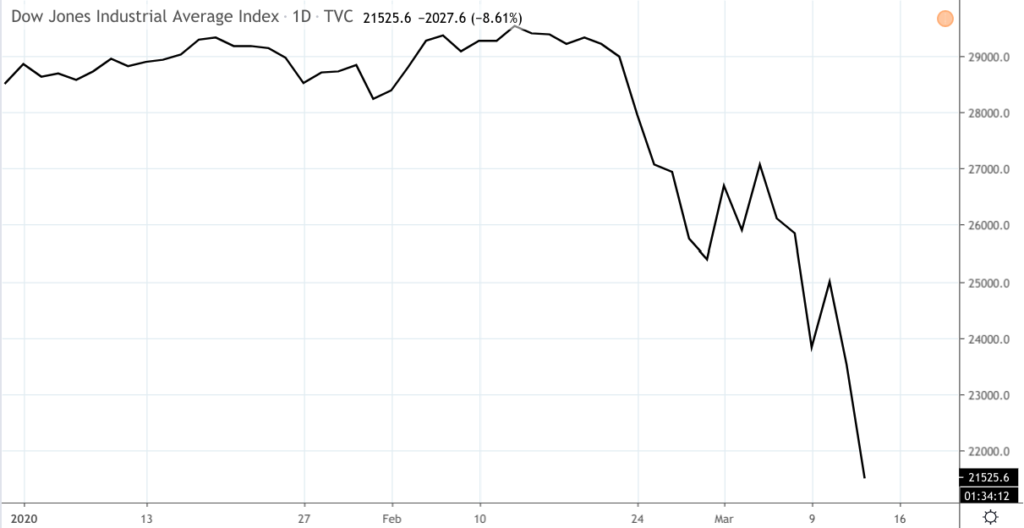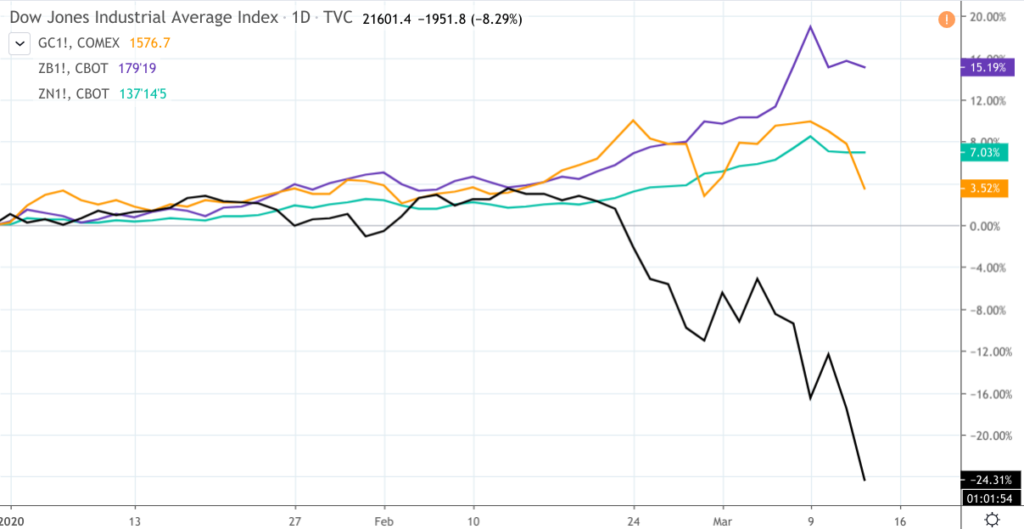
Dow Jones Industrial Average Index – January 2 to March 12, 2020
US markets have been on an accelerated decline due to Coronavirus fears since February 21, 2020.
Now, with the COVID-19 virus situation being considered a global pandemic, the markets are in a panic. Furthermore, nobody knows the full impact that it might have on the global economy as news is continuously unfolding.
The implementation of a sound portfolio diversification strategy has always been a cornerstone of smart investing.
And although there’s never a bad time to diversify your portfolio. Some investors might argue that the best time to diversify is while the markets are moving steadily upward–in short, anytime over the last 11 years.
Fortunately, it’s never too late to diversify. And for stock market investors who are looking for new instruments and asset classes to diversify their portfolios now, the futures market might provide a few opportunities to do just that.
Before you invest, however, take a breath and ask a few strategic questions:
Why are you diversifying in the first place?
There are generally two reasons to diversify:
- To “hedge” against loss in one part of your portfolio; and
- To increase return sources from markets with varying correlations.
Pretty simple, right? In light of the coronavirus pandemic, chances are that you’re looking to hedge. So let’s take a closer look at what that might mean.
What are you seeking to hedge against?
Are you looking to hedge that first massive market drop? If so, you’re too late.
But if you are looking to hedge a secular bear market or a potential upcoming recession, there are a few instruments that might be effective.
Are you looking to hedge against a reduction of dollar purchasing power due to central bank stimulus? That’s what safe haven assets are for.
Some commodities have little to no correlation to the stock market, while others have negative correlation (meaning that they might go up when stocks go down).
As far as recessionary and inflationary diversification hedges, below are a few popular ones (Gold, 30-Year Treasuries & 10-Year Treasuries) that have been overlaid on top of the Dow Jones chart that we saw above.

Dow Jones, Gold, 30-Year Treasuries, and 10-Year Treasuries – January 2 to March 12, 2020
What are we to say of investors who held treasuries and gold in addition to stocks?
The Bottom Line
Diversifying your portfolio is a lot like wearing a seatbelt while driving your vehicle.
When you strap on your seatbelt, you are not forecasting a crash. You are just being safe in case you have one.
If you do have a serious crash, you will likely still be injured, but your injuries hopefully won’t be fatal.
When diversifying your portfolio, you are not necessarily forecasting a crash (although we just had a pretty big one).
Diversification will not guarantee that your investments will be safe from economic disaster. But, if you diversify wisely, you just might gain some upside when other assets decline or plunge.
Furthermore, commodities have varying correlations with stocks. So you might want to check the futures markets for potential diversification candidates. Do your homework, be strategic, and remember to always wear your seatbelt when driving.
Please be aware that the content of this blog is based upon the opinions and research of GFF Brokers and its staff and should not be treated as trade recommendations. There is a substantial risk of loss in trading futures, options and forex. Past performance is not necessarily indicative of future results.
Disclaimer Regarding Hypothetical Performance Results: HYPOTHETICAL PERFORMANCE RESULTS HAVE MANY INHERENT LIMITATIONS, SOME OF WHICH ARE DESCRIBED BELOW. NO REPRESENTATION IS BEING MADE THAT ANY ACCOUNT WILL OR IS LIKELY TO ACHIEVE PROFITS OR LOSSES SIMILAR TO THOSE SHOWN. IN FACT, THERE ARE FREQUENTLY SHARP DIFFERENCES BETWEEN HYPOTHETICAL PERFORMANCE RESULTS AND THE ACTUAL RESULTS SUBSEQUENTLY ACHIEVED BY ANY PARTICULAR TRADING PROGRAM.
ONE OF THE LIMITATIONS OF HYPOTHETICAL PERFORMANCE RESULTS IS THAT THEY ARE GENERALLY PREPARED WITH THE BENEFIT OF HINDSIGHT. IN ADDITION, HYPOTHETICAL TRADING DOES NOT INVOLVE FINANCIAL RISK, AND NO HYPOTHETICAL TRADING RECORD CAN COMPLETELY ACCOUNT FOR THE IMPACT OF FINANCIAL RISK IN ACTUAL TRADING. FOR EXAMPLE, THE ABILITY TO WITHSTAND LOSSES OR TO ADHERE TO A PARTICULAR TRADING PROGRAM IN SPITE OF TRADING LOSSES ARE MATERIAL POINTS WHICH CAN ALSO ADVERSELY AFFECT ACTUAL TRADING RESULTS. THERE ARE NUMEROUS OTHER FACTORS RELATED TO THE MARKETS IN GENERAL OR TO THE IMPLEMENTATION OF ANY SPECIFIC TRADING PROGRAM WHICH CANNOT BE FULLY ACCOUNTED FOR IN THE PREPARATION OF HYPOTHETICAL PERFORMANCE RESULTS AND ALL OF WHICH CAN ADVERSELY AFFECT ACTUAL TRADING RESULTS.